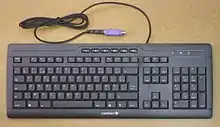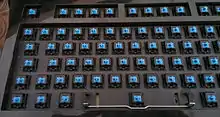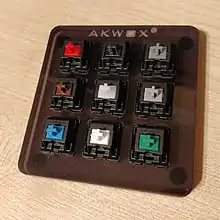Cherry (company)
Cherry GmbH (formerly Cherry Corporation and stylized as CHERRY) is a German computer peripheral-device maker. The company has its roots in the United States and is headquartered in Germany.[1][2] It has additional offices in the United States, France, and China.[2] They manufactured a large range of products including sensors, vibrators and automotive modules until 1976, when Peter Cherry, the son of Walter L. Cherry, sold his company to ZF Friedrichshafen AG, a German supplier to the automotive industry. Cherry was renamed ZF Electronics GmbH, while the Cherry brand was continued only for its computer input devices. Since the beginning of 2016 this product line has been operating independently on the market as the Cherry Group. After an eight-year partnership with ZF Friedrichshafen AG, Cherry (the computer input device manufacturer) was sold to GENUI Partners in October 2016.[3]
 | |
| Type | Corporation |
|---|---|
| Industry | Electronic switches Computer hardware |
| Founded | 1953 |
| Founder | Walter Lorraine Kirsch |
| Headquarters | , Germany |
Key people | Rolf Unterberger (CEO), Bernd Wagner (CFO) |
| Revenue | €250 million (2007) |
Number of employees | 380 (2015) |
| Parent | GENUI Partners |
| Website | www www |
History


Cherry was founded by Walter Cherry in 1953 in the basement of a restaurant in Highland Park, Illinois, USA. With the passing of its founder, his son Peter took over the ownership of the organization. The company's headquarters were moved to Auerbach in der Oberpfalz, Germany in 1979. Cherry has manufactured keyboards since 1973,[1] and claims to be the oldest keyboard manufacturer still in business.[4]
In 2008, Cherry was bought by ZF Friedrichshafen AG and incorporated as the ZF Electronics GmbH Corporate Division. The Cherry brand continues to be used.
In 2019, the company attracted controversy when it offered a giveaway that excluded female gamers, resulting in a boycott by some users in China. The company argued that it would still give prizes to women, amending the giveaway.[5]
Cherry maintains production facilities in Europe (most notably in Bayreuth, Germany), Asia, and the Americas. All of its products are designed and developed at the company's headquarters in Auerbach in der Oberpfalz. It also has offices in the UK, Italy, France, Hong Kong, India, Mexico, Australia and other locations, with distributors in most major countries.
Products
Among Cherry's widely known products are its line of MX and ML key switches, including red, blue, and brown switches, that have been used in industrial electronics and point of sale environments since their inception in the 1980s, and more recently (~2008) by numerous manufacturers of consumer PC keyboards.
At CES 2017, the company announced an update of its "classic" G80-3000 keyboard, with a noise reduction. The Verge said that the new version "fixed a fatal flaw" with the company's mechanical keyboards – their clicking keyboard noises.[6] According to TechCrunch, Cherry "has long been the de facto standard for mechanical keyboard switches." Three years later, the company launches it first "fully mechanical switch" intended for the "value market," or lower cost keyboards.[7]
Currently, Cherry makes the following products:
- Keyboards
- Mice
- Card reader
- Peripheral
- MIX Technology
Cherry MX switches in consumer keyboards



Cherry MX switches were developed and patented in the early 1980s and first marketed around 1985. In the consumer keyboard market, Cherry MX switches are often referenced by the color of the key stem—the part of the switch below the keycap which moves downward when pressed.[8]
Keyboard makers such as Cooler Master, Corsair, and G.Skill use Cherry's Cherry MX switches in their designs or "imitate them,"[9] such as Razer's Kale Green switches in the first Generation Razer Blackwidow Chroma.[10] Cherry sells its own keyboards in "modest volumes." Its MX 10. TKL keyboard lacks the tenkey section of the keyboard.[11] In 2018, the company introduced mechanical keyboard switches for thinner keyboards.[12] It makes its Cherry MX Silent switches, or Pink switches, as a range on keyboards like the Corsair K70.[13]
Most common Cherry MX switches are:
- Linear
- Red
- Silent Red
- Speed Silver
- Nature White
- Black
- Silent Black
- Linear Grey
- Tactile, non-clicky
- Brown
- Clear
- Tactile Grey
- Tactile and Clicky
- Blue
- White
- Green
Cherry MX Grey switches can be found in Linear, Tactile, and Clicky variants. They are distinguished by stem color, with Linear being darker than Tactile. The Clicky version is no longer made. It is debated as to whether it even clicks, since it is not listed as a "click" switch by Cherry in their 1994 "Keymodule MX brochure", along with MX Whites, which are greased to reduce the click.[14] Given their use primarily in large keys like Space Bar, the feel is selected to match that of the other keys on the board.
Other types of Cherry MX switches, such as Green and Grey, are used for larger keys (Space Bar, ⇧ Shift, ↵ Enter, etc.). The feel of Cherry MX green switches are often compared to that of the "buckling spring" switches on original IBM Model M keyboards.[15] Cherry switches have an advertised lifespan of up to 100 million actuations, depending on switch type.[16]
The auditory and tactile nature of each switch, and the amount of force needed to actuate it, vary depending on the switch type:
| Switch type | Clicky | Tactile | Linear | Actuation force | Tactile force | Actuation point | Total travel | Product code | Type |
|---|---|---|---|---|---|---|---|---|---|
| Red | No | No | Yes | 0.45 N | N/A | 2.0 mm | 4.0 mm | MX1A-L1xx | Normal |
| Silent Red | No | No | Yes | 0.45 N | N/A | 1.9 mm | 3.7 mm | MX3A-L1xx | Normal |
| Speed Silver | No | No | Yes | 0.45 N | N/A | 1.2 mm | 3.4 mm | MX1A-51xx | Normal |
| Nature White | No | No | Yes | 0.55 N | N/A | 2.0 mm | 4.0 mm | MX1A-41NA | Normal |
| Black | No | No | Yes | 0.60 N | N/A | 2.0 mm | 4.0 mm | MX1A-11xx | Normal |
| Silent Black | No | No | Yes | 0.60 N | N/A | 1.9 mm | 3.7 mm | MX3A-11xx | Normal |
| Linear Grey | No | No | Yes | 0.80 N | N/A | 2.0 mm | 4.0 mm | MX1A-21xx | Larger keys |
| Brown | No | Yes | No | 0.45 N | 0.55 N | 2.0 mm | 4.0 mm | MX1A-G1xx | Normal |
| Clear | No | Yes | No | 0.55 N | 0.65 N | 2.0 mm | 4.0 mm | MX1A-C1xx | Larger keys |
| Tactile Grey | No | Yes | No | 0.80 N | 0.80 N | 2.0 mm | 4.0 mm | MX1A-D1xx | Larger keys |
| Blue | Yes | Yes | No | 0.50 N | 0.60 N | 2.2 mm | 4.0 mm | MX1A-E1xx | Normal |
| White / new White | Yes | Yes | No | 0.50 N / 0.70 N | 0.60 N / 0.80 N | 2.0 mm | 4.0 mm | MX1A-A1xx | Normal / Larger keys |
| Green | Yes | Yes | No | 0.70 N | 0.80 N | 2.2 mm | 4.0 mm | MX1A-F1xx | Larger keys |
Awards
In 2008, Cherry's production facility in Bayreuth received the Bayerischer Qualitätspreis 2008 award.[17] At the end of 2006, Cherry received the Automotive Lean Production Award of the German economy magazine Automobil-Produktion. In 2005, Cherry GmbH in Auerbach received the Industrial Excellence Award as best European industrial facility.
See also
References
- "About us". CHERRY Americas. Retrieved 24 May 2019.
- "Locations". CHERRY Americas. Archived from the original on 6 June 2017. Retrieved 17 June 2017.
- "GENUI Acquires ZF Subsidiary Cherry". ZF Friedrichshafen AG. Archived from the original on 29 August 2018. Retrieved 28 August 2018.
- "cherry.de - Über Cherry". Archived from the original on 24 December 2010. Retrieved 2 January 2011.
- "Chinese gamers threaten keyboard maker Cherry with boycott after storm over giveaway aimed at ‘men only’" SCMP
- Gartenberg, Chaim (5 January 2017). "Famed switch manufacturer Cherry is making its own silent mechanical keyboard". The Verge.
- Lardinois, Frederic (10 January 2020). "Cherry goes downmarket with its new Viola mechanical keyboard switches". TechCrunch.
- "Cherry MX". Deskthority wiki. 6 September 2013. Retrieved 11 September 2013.
- "The Best Keyboards for 2020". PCMAG. Retrieved 6 October 2020.
- "Best Mechanical Switches for Gaming in 2020". Pro Tech Reviewer. Retrieved 6 October 2020.
- Sexton, Michael (13 February 2019). "Cherry MX 1.0 TKL Review". PCMag.
- Lardinois, Frederic (12 January 2018). "Cherry's new low-profile switches may help bring mechanical keyboards to more laptops". TechCrunch.
- "The best gaming and media keyboards, according to Polygon staffers". Polygon. 6 March 2020.
- "Cherry MX Click Grey". Deskthority wiki. Retrieved 22 October 2017.
- Kowaliski, Cyril (7 March 2013). "A first look at Cherry's MX green key switches: Eat your heart out, buckling springs". The Tech Report. Retrieved 22 October 2017.
In both feel and specifications, though, the greens are closer to the buckling spring switches of IBM's iconic Model M keyboards. That makes them uniquely appealing to old-school geeks.
- "Cherry MX Red data sheet" (PDF). Cherry MX Switches. 8 September 2020. Retrieved 8 September 2020.
Durability: > 100 million actuations
- Bayerischer Qualitätspreis 2008 Archived 2014-04-13 at the Wayback Machine (in German)
External links
- Cherry website
- Cherry switches website
- ZF Switches & Sensors website (previously Cherry Switches)
- Overview of Cherry mechanical switches
- Cherry MX mechanical switches guide (with sounds of each switch)